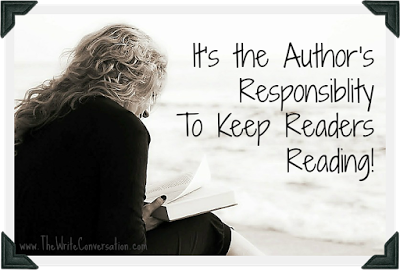It's the Author's Responsibility to Keep Readers Reading
by Cindy Sproles @CindyDevoted
 J. R. Ewing heard a noise outside his office door. He walked into the hallway and BOOM! Shot. Twice. This was the season ender for the 1980 television show, Dallas. America was taken back when they realized they were left without the answers to two questions: Was J. R. Ewing dead? Who shot him?
J. R. Ewing heard a noise outside his office door. He walked into the hallway and BOOM! Shot. Twice. This was the season ender for the 1980 television show, Dallas. America was taken back when they realized they were left without the answers to two questions: Was J. R. Ewing dead? Who shot him?
That closing scene was every writers dream come true . . . having the viewer/reader hungry for more.
Fiction is the most read genre in the country. Not only do authors vie for a spot on the fiction shelves of a bookstore, bigger yet, they vie for the reader’s attention. Thanks to the world of technology and media bumping up a viewer’s expectations, writers must step up the pace to draw the reader in.The Writer’s ResponsibilityGone are the days of fluff–setting a lovely, soft scene for the opening paragraph. Today, readers thumb through a book and count the pages in the first few chapters. Readers no longer care how many chapters a book has, as long as they can read them quickly.
 It’s our job to hone the craft, unleashing the creativity that lays beneath the surface. Current day readers demand more of the stories they read and we are forced to give them what they want. Otherwise, they choose the theatre over a good book.
It’s our job to hone the craft, unleashing the creativity that lays beneath the surface. Current day readers demand more of the stories they read and we are forced to give them what they want. Otherwise, they choose the theatre over a good book.
Now, more than ever, the responsibility of the writer becomes grittier, and we are forced to offer the reader a more vivid reading experience by tapping into the depths of their emotion. Dinging the senses of the reader causes them to invest deeper into the story and become emotionally involved.
THE HOOK There was a time when the hook could be anywhere on the first page. Not anymore. Stretch your imagination and get that hook in the first paragraph. If you want to really wow the reader . . . the first line.
There was a time when the hook could be anywhere on the first page. Not anymore. Stretch your imagination and get that hook in the first paragraph. If you want to really wow the reader . . . the first line.
Readers today want instant gratification, a sudden jolt into the movement and pace of the work. The hook should be so powerful and engaging, that the reader asks the question, “What is going on here?” The writers hand should be so strong that it stretches out of the first paragraph wrapping its fingers around the neck of the reader, yanking them head first into a fictional bubble they have no desire to leave.
THE FICTIONAL BUBBLEBuilding the fictional bubble remains an important writing staple. It’s creating a world that draws your reader in and allows them to shut out the reality around them. The fictional bubble is where the reader escapes to relish and savor the story they are seeing unfold.
 So how do we build a stronger fictional bubble? Research. Do your homework. Know the subject you are writing about. The greater your knowledge on the subject you write about, the deeper you can draw the reader in with unique literary description and detail. It means you, the writer become a great liar, spinning a story of twists and turns, only dropping in enough untruth, to make the reader question. The instant your description becomes cliché, pushes too far, or turns inaccurate . . . the second your reader knows more than you . . . the fictional bubble pops and you lose the reader. Creating this bubble that manipulates your reader and drives the story ahead is a tough job. No one ever said writing was easy. It’s filled with reader expectation and if you let them down, take them from their bubble, your readers are disappointed.
So how do we build a stronger fictional bubble? Research. Do your homework. Know the subject you are writing about. The greater your knowledge on the subject you write about, the deeper you can draw the reader in with unique literary description and detail. It means you, the writer become a great liar, spinning a story of twists and turns, only dropping in enough untruth, to make the reader question. The instant your description becomes cliché, pushes too far, or turns inaccurate . . . the second your reader knows more than you . . . the fictional bubble pops and you lose the reader. Creating this bubble that manipulates your reader and drives the story ahead is a tough job. No one ever said writing was easy. It’s filled with reader expectation and if you let them down, take them from their bubble, your readers are disappointed.
THE CLIFFHANGEREnding every chapter with a cliffhanger drives the reader into a “can’t put it down” mode. It’s important to understand cliffhangers are not always action packed. They can simply leave the reader mid-stream of a thought.
The lights in the theatre dimmed. He was three rows in front me. And I needed to ask him a question.
Something this simple strikes the reader’s curiosity and forces their desire to know. Action or disaster at the end of each chapter isn’t always necessary to keep readers guessing. Sometimes it’s just a question. The point is to end every chapter with a line that catapults the reader forward.
It’s up to the writer to stretch and hone their skill in order to keep them reading. When you make the effort to step up the pace of your writing, your stories will have meat on the bones and your readers will no longer be “just readers.” They will be fans.
How do you keep readers reading? Be sure to share your own tips in the comments section below!
TWEETABLESTips for Writers: How to Keep them Reading - @CindyDevoted on @EdieMelson (Click to Tweet)
It's our responsibility as authors to keep readers reading - @CindyDevoted on @EdieMelson (Click to Tweet)
 Cindy Sproles is an author and popular speaker. She is the cofounder of Christian Devotions ministries and managing editor of Straight Street Books and SonRise Devotionals, imprints of Lighthouse Publishing of the Carolinas. Cindy is the executive editor of www.christiandevotions.us and www.inspireafire.com. She teaches at writers conferences nationwide and directs The Asheville Christian Writers Conference - Writers Boot Camp.
Cindy Sproles is an author and popular speaker. She is the cofounder of Christian Devotions ministries and managing editor of Straight Street Books and SonRise Devotionals, imprints of Lighthouse Publishing of the Carolinas. Cindy is the executive editor of www.christiandevotions.us and www.inspireafire.com. She teaches at writers conferences nationwide and directs The Asheville Christian Writers Conference - Writers Boot Camp.
She is the author of two devotionals, He Said, She Said - Learning to Live a Life of Passion and New Sheets - Thirty Days to Refine You into the Woman You Can Be. Cindy's debut novel, Mercy's Rain, is available at major retailers. Visit Cindy at www.cindysproles.com and book her for your next conference or ladies retreat. Also connect with her on Facebook and Twitter.
 J. R. Ewing heard a noise outside his office door. He walked into the hallway and BOOM! Shot. Twice. This was the season ender for the 1980 television show, Dallas. America was taken back when they realized they were left without the answers to two questions: Was J. R. Ewing dead? Who shot him?
J. R. Ewing heard a noise outside his office door. He walked into the hallway and BOOM! Shot. Twice. This was the season ender for the 1980 television show, Dallas. America was taken back when they realized they were left without the answers to two questions: Was J. R. Ewing dead? Who shot him?That closing scene was every writers dream come true . . . having the viewer/reader hungry for more.
Fiction is the most read genre in the country. Not only do authors vie for a spot on the fiction shelves of a bookstore, bigger yet, they vie for the reader’s attention. Thanks to the world of technology and media bumping up a viewer’s expectations, writers must step up the pace to draw the reader in.The Writer’s ResponsibilityGone are the days of fluff–setting a lovely, soft scene for the opening paragraph. Today, readers thumb through a book and count the pages in the first few chapters. Readers no longer care how many chapters a book has, as long as they can read them quickly.
 It’s our job to hone the craft, unleashing the creativity that lays beneath the surface. Current day readers demand more of the stories they read and we are forced to give them what they want. Otherwise, they choose the theatre over a good book.
It’s our job to hone the craft, unleashing the creativity that lays beneath the surface. Current day readers demand more of the stories they read and we are forced to give them what they want. Otherwise, they choose the theatre over a good book.Now, more than ever, the responsibility of the writer becomes grittier, and we are forced to offer the reader a more vivid reading experience by tapping into the depths of their emotion. Dinging the senses of the reader causes them to invest deeper into the story and become emotionally involved.
THE HOOK
 There was a time when the hook could be anywhere on the first page. Not anymore. Stretch your imagination and get that hook in the first paragraph. If you want to really wow the reader . . . the first line.
There was a time when the hook could be anywhere on the first page. Not anymore. Stretch your imagination and get that hook in the first paragraph. If you want to really wow the reader . . . the first line. Readers today want instant gratification, a sudden jolt into the movement and pace of the work. The hook should be so powerful and engaging, that the reader asks the question, “What is going on here?” The writers hand should be so strong that it stretches out of the first paragraph wrapping its fingers around the neck of the reader, yanking them head first into a fictional bubble they have no desire to leave.
THE FICTIONAL BUBBLEBuilding the fictional bubble remains an important writing staple. It’s creating a world that draws your reader in and allows them to shut out the reality around them. The fictional bubble is where the reader escapes to relish and savor the story they are seeing unfold.
 So how do we build a stronger fictional bubble? Research. Do your homework. Know the subject you are writing about. The greater your knowledge on the subject you write about, the deeper you can draw the reader in with unique literary description and detail. It means you, the writer become a great liar, spinning a story of twists and turns, only dropping in enough untruth, to make the reader question. The instant your description becomes cliché, pushes too far, or turns inaccurate . . . the second your reader knows more than you . . . the fictional bubble pops and you lose the reader. Creating this bubble that manipulates your reader and drives the story ahead is a tough job. No one ever said writing was easy. It’s filled with reader expectation and if you let them down, take them from their bubble, your readers are disappointed.
So how do we build a stronger fictional bubble? Research. Do your homework. Know the subject you are writing about. The greater your knowledge on the subject you write about, the deeper you can draw the reader in with unique literary description and detail. It means you, the writer become a great liar, spinning a story of twists and turns, only dropping in enough untruth, to make the reader question. The instant your description becomes cliché, pushes too far, or turns inaccurate . . . the second your reader knows more than you . . . the fictional bubble pops and you lose the reader. Creating this bubble that manipulates your reader and drives the story ahead is a tough job. No one ever said writing was easy. It’s filled with reader expectation and if you let them down, take them from their bubble, your readers are disappointed.THE CLIFFHANGEREnding every chapter with a cliffhanger drives the reader into a “can’t put it down” mode. It’s important to understand cliffhangers are not always action packed. They can simply leave the reader mid-stream of a thought.
The lights in the theatre dimmed. He was three rows in front me. And I needed to ask him a question.
Something this simple strikes the reader’s curiosity and forces their desire to know. Action or disaster at the end of each chapter isn’t always necessary to keep readers guessing. Sometimes it’s just a question. The point is to end every chapter with a line that catapults the reader forward.
It’s up to the writer to stretch and hone their skill in order to keep them reading. When you make the effort to step up the pace of your writing, your stories will have meat on the bones and your readers will no longer be “just readers.” They will be fans.
How do you keep readers reading? Be sure to share your own tips in the comments section below!
TWEETABLESTips for Writers: How to Keep them Reading - @CindyDevoted on @EdieMelson (Click to Tweet)
It's our responsibility as authors to keep readers reading - @CindyDevoted on @EdieMelson (Click to Tweet)
 Cindy Sproles is an author and popular speaker. She is the cofounder of Christian Devotions ministries and managing editor of Straight Street Books and SonRise Devotionals, imprints of Lighthouse Publishing of the Carolinas. Cindy is the executive editor of www.christiandevotions.us and www.inspireafire.com. She teaches at writers conferences nationwide and directs The Asheville Christian Writers Conference - Writers Boot Camp.
Cindy Sproles is an author and popular speaker. She is the cofounder of Christian Devotions ministries and managing editor of Straight Street Books and SonRise Devotionals, imprints of Lighthouse Publishing of the Carolinas. Cindy is the executive editor of www.christiandevotions.us and www.inspireafire.com. She teaches at writers conferences nationwide and directs The Asheville Christian Writers Conference - Writers Boot Camp. She is the author of two devotionals, He Said, She Said - Learning to Live a Life of Passion and New Sheets - Thirty Days to Refine You into the Woman You Can Be. Cindy's debut novel, Mercy's Rain, is available at major retailers. Visit Cindy at www.cindysproles.com and book her for your next conference or ladies retreat. Also connect with her on Facebook and Twitter.
Published on August 11, 2015 01:00
No comments have been added yet.



